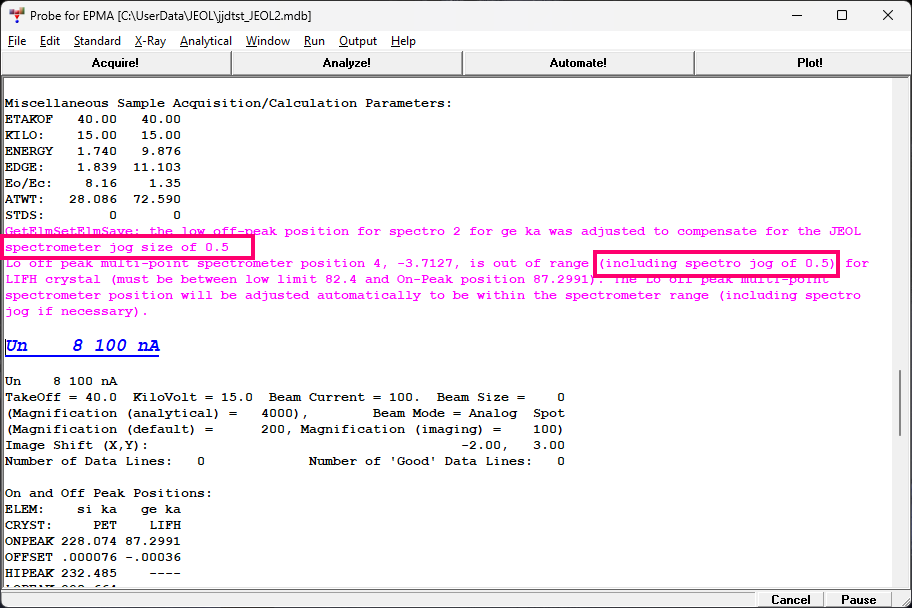Scott Boroughs and I have been looking at situations where the emission line of interest is close to the lower limit of the spectrometer range on JEOL instruments. Probe for EPMA has included an automatic adjustment to account for the built in JEOL jog that can exceed the lower limit in these cases.
But previously we had assumed a constant 0.6 mm spectrometer jog, which might not be what your instrument actually uses, so recently we modified the code to utilize the actual JEOL backlash value from the MOTORS.DAT file as seen here:
"SP1" "SP2" "SP3" "SP4" "SP5" "X" "Y" "Z" "motor labels"
60.4 82.4 60.4 60.4 60.4 1.5 1.8 9.0 "low limit spect/stage motors"
254.0 254.0 254.0 254.0 254.0 99.2 99.2 12.9 "high limit spect/stage motors hilim"
742.8646 742.8646 742.8646 742.8646 742.8646 27593.425 27593.425 27593.425 "unit to steps conversion"
.014381 .014381 .014381 .014381 .014381 1000.0 1000.0 1000.0 "unit to LiF200 angstrom or micron conversion"
5 5 5 5 5 20 20 20 "completion step tolerance for motors"
-400. -400. -400. -400. -400. -400. -400. -400. "backlash size, (hilimit - lolimit)/backlash size"
200 200 200 200 200 200 200 200 "derivative gain"
750 750 750 750 750 700 700 700 "integral gain"
700 700 700 700 700 700 700 700 "integration limit"
2000 2000 2000 2000 2000 2000 2000 2000 "following error"
20 20 20 20 20 300 300 300 "acceleration"
200000 200000 200000 200000 200000 400000 400000 400000 "velocity"
600 600 600 600 600 700 700 700 "gain"
11 11 11 11 11 11 11 11 "hard limit mode (low xor high xor smooth)"
1.0 1.0 1.0 1.0 1.0 1.0 1.0 1.0 "joystick sensitivity"
1.4 1.4 1.4 1.4 1.4 1.4 1.4 1.4 "joystick acceleration"
.002 .002 .002 .002 .002 .002 .002 .002 "backlash tolerance"
180.0 180.0 180.0 180.0 180.0 12 12 10 "park positions"
500000 500000 500000 500000 500000 400000 400000 40000 "JEOL velocities"
50000 50000 50000 50000 50000 -5000 -5000 5000 "Jeol Backlash (1/100th micrometer units)"
0 0 0 0 0 0 0 0 "SX100 velocities"
0 0 0 0 0 0 0 0 "SX100 minimum speeds"
0 0 0 0 0 0 0 0 "unused"
Note that the JEOL backlash values are specified in 1/100th micrometer units (this is what JEOL uses internally to avoid floating point math!), therefore 50000 equals 500 um or 0.5 mm. The new code uses these JEOL backlash values from the MOTORS.DAT file whatever they may be.
On 8900/8200 and 8500 instruments these values are read in from the MOTORS.DAT and sent to the JEOL instrument so they will be utilized in the automatic backlash adjustments for the spectrometers and stage.
Note also that the newer 8230/8530/iSP100 and iHP200F instruments do not have an API command to accept these JEOL backlash values sent through the instrument network, so the values in the JEOL PC-EPMA software will need to be edited so they match the values in the MOTORS.DAT file on these newer instruments. Though to be honest we do not know where in the JEOL PC-EPMA software these backlash values are edited, so if anyone does know, please let us know here.
Note also that these backlash values from the MOTORS.DAT will be utilized based on these keywords in the Probewin.ini file and explained in the Probe for EPMA User's Reference Manual:
SpecBacklashFlag=1 ; spectro backlash
StageBacklashFlag=1 ; stage backlash
SpecBacklashType=1 ; spectro backlash type, 1 = software backlash, 2 = ROM based backlash
StageBacklashType=2 ; stage backlash type, 1 = software backlash, 2 = ROM based backlash
Therefore the backlash "flag" needs to be non-zero and the backlash "type" needs to be 2 for the automatic hardware based backlash method which uses these MOTORS.DAT values. While the "smart" software backlash correction (backlash "type" = 1) (which applies to both JEOL and Cameca instruments), the "backlash factors" on line 7 in the MOTORS.DAT file are what are utilized.
Finally, we should note that although we had been checking the low off-peak, ROM scanning and peaking lower limits, we were not checking the multi-point background (MPB) limits for this JEOL backlash going beyond the lower spectrometer limit. New code to check the lower MPB positions has now been added in the latest version of Probe for EPMA (v. 13.6.9).
So now, in this latest version of PFE, if these spectrometer positions need to be adjusted, the software will provide a warning to the main log window that this adjustment was performed as seen here:
